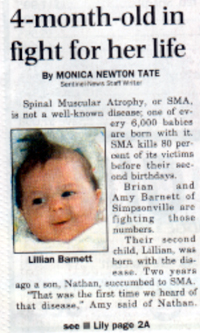|
Spinal Muscular Atrophy, or SMA, is not a well-known disease; one of every 6,000 babies is born with it. SMA kills 80% of its victims before their second birthday. Brian and Amy Barnett of Simpsonville are fighting those numbers. Their second child, Lillian, was born with the disease. Two years ago a son, Nathan, succumbed to SMA. "That was the first time we heard of that disease," Amy said of Nathan. Doctors too had trouble diagnosing the baby boy who hardly moved and had very little reflex. SMA is related to Muscular Dystrophy, or a weakening of muscles. It is genetic and scientists believe SMA is caused by a missing protein. Babies, like Nathan, usually die of pneumonia because their muscles are too weak to allow them to cough. In the Barnett household, Lily can't be touched until hands are washed. The family does not want her to catch germs linked to colds. Lily lies in her bassinet, looking like any other healthy baby, her mother notes. Her eyes are alert and intelligent. She smiles often and laughs. She wiggles her arms some, but cannot crawl. When not in the crib, the four-month-old must have her head held up by her parents. "Most doctors would say take her home and love her because there's not a cure for this," Amy said. But Dr. John Bach of Newark, N.J. has decided he will not be like most doctors and committed himself to finding new ways to combat this all-too-common killer. "He's the only doctor we have found for this thing who gives us any kind of hope," the mother said. The Barnetts had not heard of Bach until after Lily was born, and then through parent chat rooms on the Internet. "That's the only way you can get information," Amy said of the World Wide Web. "Parents are the experts of this disease, and any doctor will tell you this." Bach's treatment includes a non-invasive ventilator, which is a mask that goes on the baby's face, usually to be worn at night. That way, "her lungs get a break in breathing at night," Amy said. A simple concept, the treatment may prolong the child's life until a cure can be found. Scientists, Amy said, could find a cure in 10 years or less. Bach's method differs from conventional ventilators used for SMA infants and children. With conventional ventilators, a tube is put down the baby's throat. That tube is dangerous, Amy said, because it causes secretions the child is too young to cough up and may lead to her demise. Yet Bach's simple mask treatment is not available in any local hospitals. Like with Nathan, a tube ventilator is used. He died the day he was taken off the ventilator, Amy said. The Barnetts also are haggling with their insurance company to pay for the mask ventilator. Already, insurance has denied payment for a pulse measuring devise that would tell the Barnetts if Lily's breathing is hampered. "We're trying to be proactive in her care," Amy said, but ignorance and skepticism makes that difficult. The Barnetts' goal is to make hospitals and pediatricians aware of Bach's treatment and for hospitals to buy the machines. While the disease is passed through the genes, the Barnetts had a one-in-four chance of having a healthy baby. The couple are going through the debilitating infant disease after Nathan because, "We know of other people who had done it and had a healthy child. We didn't want to spend our lives wondering. But, we won't do it again. We'll never take the chance again." To help the Barnetts pay for Lily's treatment and give for the fight for a cure, call at 722-8749. |

